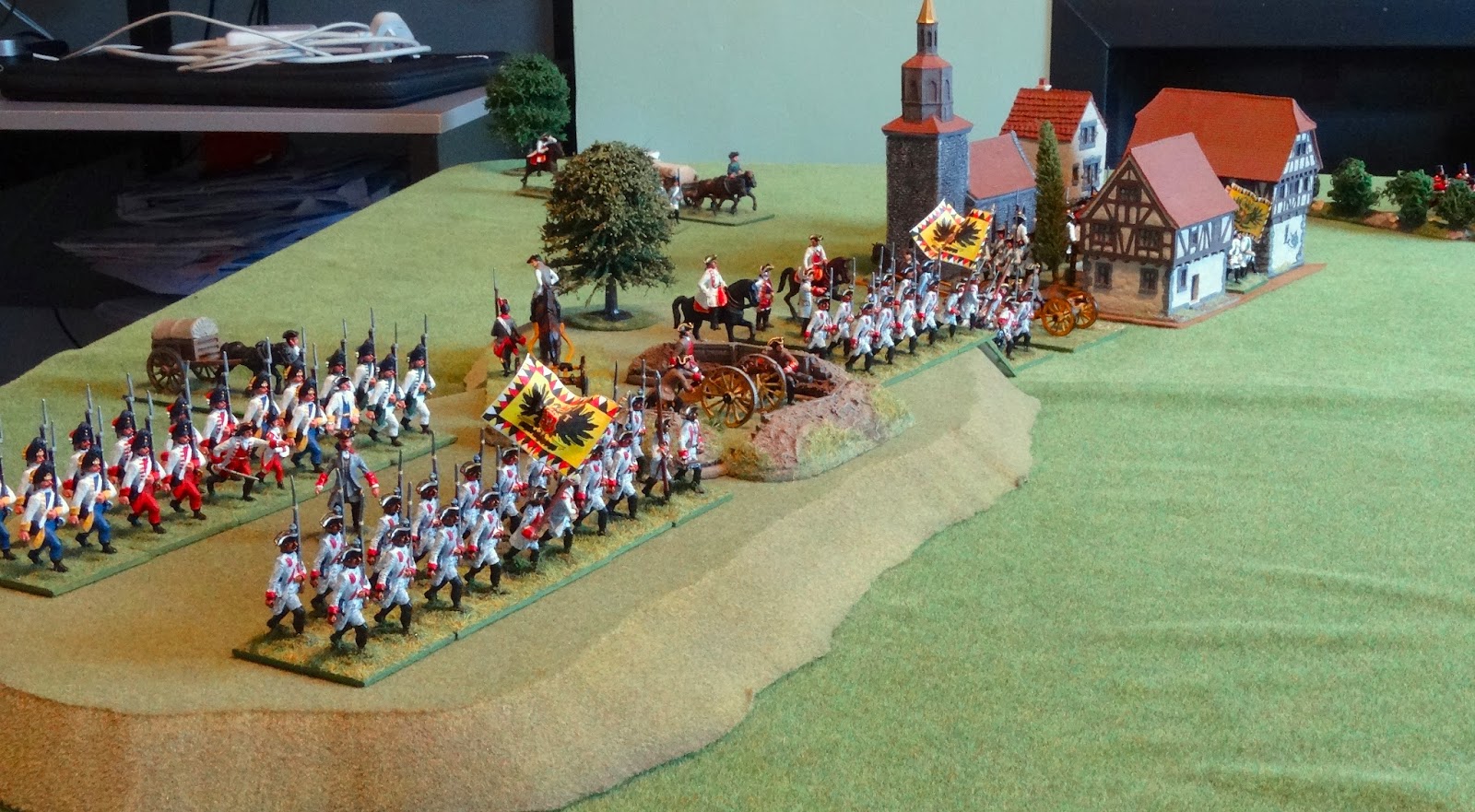Now it can be revealed. 2014 will be an interesting year for me wargaming-wise, as I have been commissioned by Osprey Publishing to write a set of wargaming rules for the Seven Years War.
The working title is Honours of War, a phrase I found in Donald Featherstone's book on this period, Wargames Through the Ages 1420-1783,
The working title is Honours of War, a phrase I found in Donald Featherstone's book on this period, Wargames Through the Ages 1420-1783,
'On the wargame table each commander will endeavour to manoeuvre the enemy
into untenable positions so that they must accept the Honours of War...'
The definition of the phrase in the Collins dictionary is,
'The honours granted by the victorious to the defeated,
esp. as of marching out with all arms and flags flying.'
So the phrase seemed to say something about 18th century warfare, as well as the spirit in which miniature wargames themselves should be played.
Most of you will be familiar with the range of Osprey rules published so far. Last year, some adverts for the range carried the invitation to send in proposals for further titles. This offer was backed up by an interview in Wargames, Soldiers and Strategy (no.68) with Phil Smith, who is head of the Osprey Wargames project. He confirmed the offer and the sort of thing Osprey were looking for.
 |
| I have enjoyed a few games of Dux Bellorum, courtesy of my old muckers Steve and Craig |
Those familiar with this blog will know I have been playing games with my own set of rules for the SYW. So in the spirit of 'what the hell', and not expecting to get anywhere, I sent off the current version to Phil.
His reply was a surprise. He wasn't completely sold, but he gave me room to get back to him and indicate how I thought his doubts could be resolved. These were mostly around making the rules inviting to those who might be new to the period, providing them with the possibility of modestly sized starter games and a points system to help them build their armies. I was able to confirm that these concerns could be fixed, along with making the rules playable with smaller figures than the 30mm ones I used.
And then there were 2 more surprises in store for me. Phil wrote back saying he felt I had addressed his concerns and was prepared to take my proposal to a publishing meeting and pitch it to those involved. Crikey. Then, not long after, he emailed me to say 'we have a wargame'. In other words, my proposal was accepted, and I had around a year to get the rules re-written, play tested, and ready for publication with associated diagrams and illustrations. I was gobsmacked. What an opportunity!
This was at the end of September last year. Since then I have been working the rules up towards a publishable standard. This has involved widening them to include all the nations involved in the SYW in Europe (rather than just Prussia and Austria), developing a points system, showing how the rules would work for 15mm, 10mm and 6mm models, and writing all the introductions, explanations and explanatory diagrams needed to make everything understandable to someone completely new to the rules.
The work so far has been great - my knowledge of the period is now much improved, and the intellectual exercise of getting everything together has been very rewarding. Phil at Osprey has been helpful and supportive - having the backing of a decent-sized publisher will make this project so much more enjoyable. Assuming all goes well, it will be great to get my work out there and see what people think about it. And then there will be the buzz of going to wargames shows or visiting blogs and seeing people enjoying playing games with my rules. Plus I might even make a few quid to spend on more toys!
The work so far has been great - my knowledge of the period is now much improved, and the intellectual exercise of getting everything together has been very rewarding. Phil at Osprey has been helpful and supportive - having the backing of a decent-sized publisher will make this project so much more enjoyable. Assuming all goes well, it will be great to get my work out there and see what people think about it. And then there will be the buzz of going to wargames shows or visiting blogs and seeing people enjoying playing games with my rules. Plus I might even make a few quid to spend on more toys!
But before all that comes the playtesting. This is where you can get involved. I have to submit my final manuscript around this time next year, so until then I want to invite gamers who don't know either me or the rules to take a look at Honours of War, play them if possible, and get back to me with feedback. You might only be able to give the rules a quick read through and let me know what you think, or you might have armies for the period already and be prepared to try a few games to really test how the rules play. All genuine contributions will be gratefully received. Apart from the chance to be on the ground floor of a new set of wargames rules, I can't offer much in return, except the possibility of a name check in the rules and maybe a free copy when they get published (no promises I'm afraid).
If you're interested, you can contact me at:
keithflint57@gmail.com
Or, visit the Yahoo Group at this address and apply to join. A brief explanation of your interest would be appreciated:
http://groups.yahoo.com/group/honoursofwar
All you need to explore the rules is available for download once you've joined the group.
Publication date is planned for November 2015, so there's plenty of time. Hope you can get involved.





.jpg)

